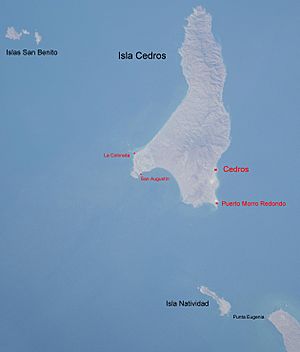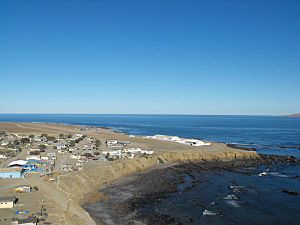Isla Natividad facts for kids

Isla Natividad is a small island in the Pacific Ocean. It is located about 6 kilometers (4 miles) west of Punta Eugenia. This point is on the coast of Baja California Sur, a state in Mexico. A tiny rock island called Roca María is just off its northwest tip.
Isla Natividad is separated from the mainland by a channel called Canal de Dewey. To the north, about 15 kilometers (9 miles) away, is Cedros Island. Another channel, Canal de Keller, separates these two islands.
The island is part of the Bahía Tortugas area within the Mulegé municipality. Isla Natividad is about 8.65 square kilometers (3.34 square miles) in size. In 2001, about 384 people lived there. Most residents live in a community also called Natividad. They are mainly fishermen who catch abalone, lobster, and clams. The island has a small airstrip to connect with the mainland. There is also a lighthouse on the northern part of the island.
Contents
Island Geography and Nature
Isla Natividad has steep, rocky shores. These shores are often surrounded by rocks and kelp, which is a type of seaweed. There is one small sandy beach that faces the mainland. The island itself is mostly barren and hilly. Its highest point is about 150 meters (492 feet) tall, located near the center.
Plants on the Island
The main plants on Isla Natividad are types of ice plants, like Mesembryanthemum crystallinum. You can also find cacti and small shrubs. There are no plants or animals found only on this island. This is because it is very close to the mainland. It was likely connected to the mainland many times during the ice ages when sea levels were lower. However, some special cacti, like Mammillaria pondii, grow here. A rare plant called Mentzelia hirsutissima var. nesiotes is also found in a few places.
Animals and Wildlife
Not many native land animals live on Isla Natividad. You might see the deer mouse (Peromyscus maniculatus) and some lizards. The island is very important for seabirds and seals. They use it as a place to breed and rest.
Isla Natividad is one of the most southern places where Cassin's auklets breed. It is also a major breeding ground for black-vented shearwaters. These birds are important to the island's ecosystem.
Conservation and Restoration Efforts
Between 1997 and 2001, a group called Conservacion de Islas worked on the island. They removed animals that had been brought there by humans. These included goats, sheep, cats, and dogs. Removing these animals helped the native wildlife. The main goal was to protect the black-vented shearwaters. These birds were being harmed by the introduced animals.
See also
 In Spanish: Isla Natividad para niños
In Spanish: Isla Natividad para niños


